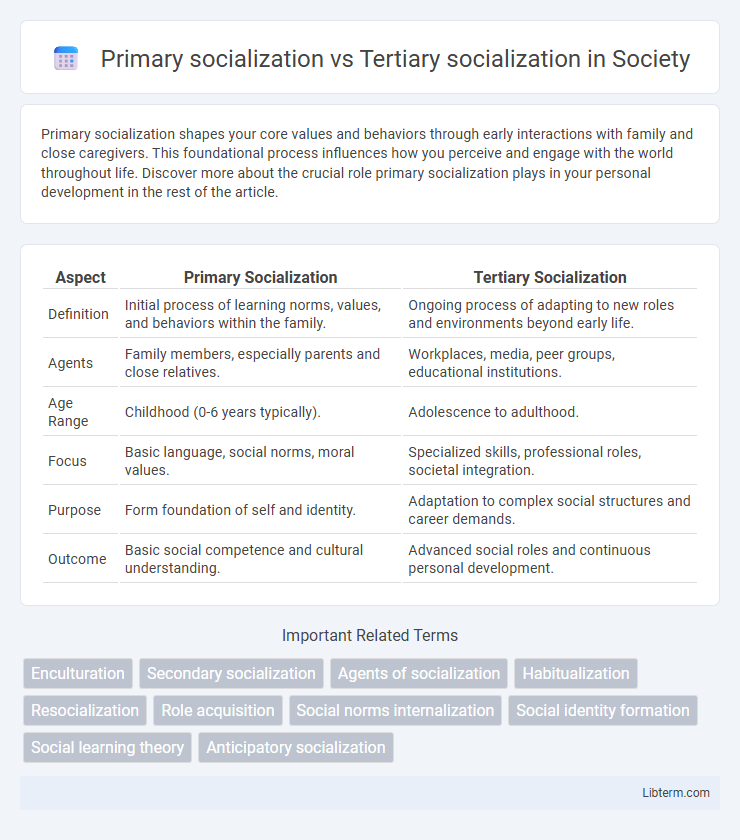Primary socialization shapes your core values and behaviors through early interactions with family and close caregivers. This foundational process influences how you perceive and engage with the world throughout life. Discover more about the crucial role primary socialization plays in your personal development in the rest of the article.
Table of Comparison
| Aspect | Primary Socialization | Tertiary Socialization |
|---|---|---|
| Definition | Initial process of learning norms, values, and behaviors within the family. | Ongoing process of adapting to new roles and environments beyond early life. |
| Agents | Family members, especially parents and close relatives. | Workplaces, media, peer groups, educational institutions. |
| Age Range | Childhood (0-6 years typically). | Adolescence to adulthood. |
| Focus | Basic language, social norms, moral values. | Specialized skills, professional roles, societal integration. |
| Purpose | Form foundation of self and identity. | Adaptation to complex social structures and career demands. |
| Outcome | Basic social competence and cultural understanding. | Advanced social roles and continuous personal development. |
Introduction to Socialization
Primary socialization occurs during early childhood within the family, where foundational behaviors, language, and cultural norms are first learned. Tertiary socialization takes place later in life, involving adaptation to new roles and environments such as workplaces or communities. Both processes are essential in shaping individual identity and social competence throughout different life stages.
Defining Primary Socialization
Primary socialization refers to the early phase of learning where an individual acquires basic behaviors, norms, values, and language primarily through close family interactions. This stage is crucial for developing foundational social skills and shaping identity within a cultural context. It contrasts with tertiary socialization, which involves adapting to specific subcultures or professional roles later in life.
Key Agents of Primary Socialization
Key agents of primary socialization include family members, especially parents and siblings, who play a crucial role in teaching children language, norms, values, and basic social skills during early development. This foundational stage helps individuals form their initial identity and emotional bonds, preparing them for further social experiences. Primary socialization contrasts with tertiary socialization, where institutions like media, workplaces, and peer groups influence adult behaviors and roles.
Defining Tertiary Socialization
Tertiary socialization refers to the process of learning and adapting to new roles and social environments later in life, often through experiences such as starting a new job, joining organizations, or relocating to different communities. Unlike primary socialization, which occurs during childhood through family and close caregivers, tertiary socialization involves acquiring skills, norms, and behaviors needed to function in specialized or unfamiliar social contexts as an adult. This stage plays a crucial role in ongoing identity development and social integration beyond early life social conditioning.
Unique Features of Tertiary Socialization
Tertiary socialization is characterized by the adaptation to new roles and environments typically encountered during adulthood, such as entering a new profession or joining new social groups, which distinguishes it from primary socialization that occurs in early childhood within the family. This phase involves continuous self-redefinition and learning, enabling individuals to navigate complex social structures and cultural norms beyond their initial upbringing. Tertiary socialization uniquely emphasizes lifelong learning, role flexibility, and identity transformation in response to changing social contexts.
Differences Between Primary and Tertiary Socialization
Primary socialization occurs during childhood and involves the initial learning of cultural norms, language, and values primarily through family interactions, establishing the foundation of identity and social skills. Tertiary socialization happens in adulthood, focusing on adapting to new social environments or roles, such as in workplaces or new communities, where individuals learn specific behaviors and expectations relevant to those contexts. The key difference lies in the timing and social agents involved: primary socialization is foundational and family-centered, while tertiary socialization is role-specific and context-driven.
Impact of Primary Socialization on Identity Formation
Primary socialization profoundly shapes identity formation by instilling core values, norms, and beliefs during early childhood within the family setting, which serves as the foundation for self-concept and social behavior. This initial phase of socialization influences emotional development and cognitive frameworks that persist into adulthood, guiding interactions and personality traits. In contrast, tertiary socialization adapts and refines identity in later life stages through professional, cultural, and institutional experiences but relies heavily on the groundwork laid by primary socialization.
Role of Media in Tertiary Socialization
Primary socialization occurs in early childhood through close family interactions, forming the foundation of norms, values, and behaviors, while tertiary socialization involves the lifelong process of adapting to new roles and environments beyond family and peer groups. The role of media in tertiary socialization is significant, as television, social media, and digital platforms continually introduce individuals to diverse cultural norms, ideologies, and social expectations. Media acts as a powerful agent that shapes adult identities and social skills by providing ongoing exposure to societal trends and global perspectives.
Contemporary Examples of Socialization Stages
Primary socialization occurs during early childhood when individuals learn fundamental norms, values, and behaviors from family members, shaping their initial identity and social understanding. Contemporary examples include children acquiring language skills and cultural practices at home before entering formal education. Tertiary socialization involves adapting to new social environments, such as workplaces or online communities, where individuals internalize specialized roles and professional norms to maintain social integration.
Conclusion: The Evolution of Socialization
Primary socialization establishes the crucial foundation for individual identity through early interactions with family and close caregivers, shaping core values and behaviors. Tertiary socialization continues this process across the lifespan, adapting individuals to new roles and social environments such as workplaces or cultural institutions. The evolution of socialization reflects its dynamic nature, emphasizing lifelong learning and continuous integration into diverse social contexts for effective societal functioning.
Primary socialization Infographic

 libterm.com
libterm.com